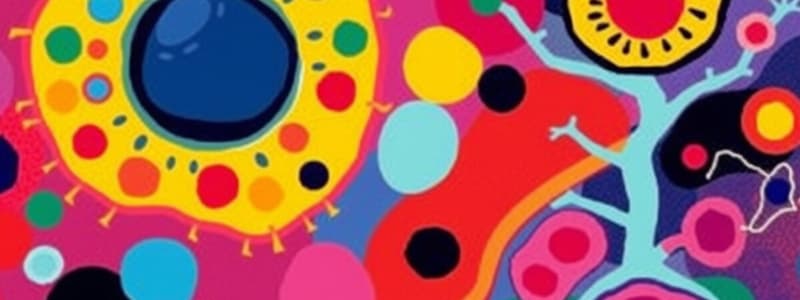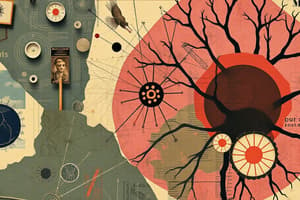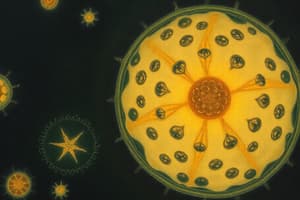Podcast
Questions and Answers
What is the primary function of the cell membrane?
What is the primary function of the cell membrane?
- Forms the boundary of the cell and regulates substance entry (correct)
- Provides mechanical support to the cell
- Synthesizes proteins
- Stores genetic material
Which organelle is involved in energy production?
Which organelle is involved in energy production?
- Ribosomes
- Mitochondria (correct)
- Golgi Complex
- Lysosomes
What distinguishes plant cells from animal cells in terms of structure?
What distinguishes plant cells from animal cells in terms of structure?
- Presence of lysosomes
- Presence of cell wall (correct)
- Absence of cell wall
- Presence of centrosome
What best describes unicellular organisms?
What best describes unicellular organisms?
Which of the following is NOT a function of the cell wall?
Which of the following is NOT a function of the cell wall?
Which component of the nucleus contains RNA for ribosome formation?
Which component of the nucleus contains RNA for ribosome formation?
What percentage of the cytoplasm is composed of water?
What percentage of the cytoplasm is composed of water?
Which of the following statements is true regarding chromosomes?
Which of the following statements is true regarding chromosomes?
What do chromatin fibers consist of?
What do chromatin fibers consist of?
Which structure serves as the control center of the cell?
Which structure serves as the control center of the cell?
Which of the following cell types is specifically mentioned as being spindle-shaped?
Which of the following cell types is specifically mentioned as being spindle-shaped?
What shape are mesophyll cells in leaves?
What shape are mesophyll cells in leaves?
Which of the following best describes the size of blood cells compared to nerve cells?
Which of the following best describes the size of blood cells compared to nerve cells?
Which type of cell has projections called pseudopodia?
Which type of cell has projections called pseudopodia?
What is the shape of guard cells of stomata in leaves?
What is the shape of guard cells of stomata in leaves?
What term did Robert Hooke use to describe the small boxes he observed in cork?
What term did Robert Hooke use to describe the small boxes he observed in cork?
What invention is directly linked to the discovery of the cell?
What invention is directly linked to the discovery of the cell?
What was one of the primary functions of cells according to the information provided?
What was one of the primary functions of cells according to the information provided?
What did Hooke discover about the cork cells he observed?
What did Hooke discover about the cork cells he observed?
What type of microscope was crucial for discovering the detailed structure of the cell?
What type of microscope was crucial for discovering the detailed structure of the cell?
What is the primary characteristic that differentiates unicellular organisms from multicellular organisms?
What is the primary characteristic that differentiates unicellular organisms from multicellular organisms?
What term describes a group of similar cells working together to carry out a specific function?
What term describes a group of similar cells working together to carry out a specific function?
Which of the following organisms is classified as unicellular?
Which of the following organisms is classified as unicellular?
What aspect of cells does Cell Theory emphasize?
What aspect of cells does Cell Theory emphasize?
What is the correct order of organization in multicellular organisms, starting from cells?
What is the correct order of organization in multicellular organisms, starting from cells?
Which of the following is NOT a characteristic of multicellular organisms?
Which of the following is NOT a characteristic of multicellular organisms?
What is a common shape for cells devoted to transport functions?
What is a common shape for cells devoted to transport functions?
Why do cells in multicellular organisms become specialized?
Why do cells in multicellular organisms become specialized?
Which structure is present in plant cells but absent in animal cells?
Which structure is present in plant cells but absent in animal cells?
What is the primary purpose of cell division in living organisms?
What is the primary purpose of cell division in living organisms?
Which of the following is a distinguishing feature of animal cells compared to plant cells?
Which of the following is a distinguishing feature of animal cells compared to plant cells?
How are cells typically studied under a microscope?
How are cells typically studied under a microscope?
What feature of vacuoles differentiates plant cells from animal cells?
What feature of vacuoles differentiates plant cells from animal cells?
What is the primary function of the cell wall?
What is the primary function of the cell wall?
Which of the following statements accurately describes ribosomes?
Which of the following statements accurately describes ribosomes?
What is a unique characteristic of mitochondria?
What is a unique characteristic of mitochondria?
Which organelle is responsible for the transport of substances within the cell?
Which organelle is responsible for the transport of substances within the cell?
What does the large central vacuole in plant cells primarily store?
What does the large central vacuole in plant cells primarily store?
Which structure is only found in animal cells?
Which structure is only found in animal cells?
Which of the following is involved in the secretion and storage of substances?
Which of the following is involved in the secretion and storage of substances?
What function do lysosomes perform in animal cells?
What function do lysosomes perform in animal cells?
What is the main function of the nucleus in a cell?
What is the main function of the nucleus in a cell?
Which type of plastid is responsible for photosynthesis?
Which type of plastid is responsible for photosynthesis?
What distinguishes plant cells from animal cells?
What distinguishes plant cells from animal cells?
What is the primary role of vacuoles in plant cells?
What is the primary role of vacuoles in plant cells?
Which of the following is NOT a type of plastid?
Which of the following is NOT a type of plastid?
What is true about red blood cells (RBCs) in humans?
What is true about red blood cells (RBCs) in humans?
What is the function of chloroplasts in plant cells?
What is the function of chloroplasts in plant cells?
How does the structure of vacuoles differ between mature and young plant cells?
How does the structure of vacuoles differ between mature and young plant cells?
Study Notes
Cell Theory
- Proposed by Schleiden and Schwann, stating that all living organisms are made of cells.
- Key points of cell theory:
- Cells are the basic structural and functional units of life.
- New cells arise from the division of existing cells.
Types of Organisms
- Unicellular organisms consist of a single cell; examples include:
- Plants: Bacteria, Chlamydomonas, Yeast.
- Animals: Amoeba, Paramecium.
- Multicellular organisms comprise multiple cells; examples include:
- Plants: Peepal, Neem, Rose.
- Animals: Earthworm, Fish, Frog, Humans.
Cell Specialization
- In multicellular organisms, cells become specialized to perform specific functions, forming:
- Tissues: Groups of similar cells performing a specific function.
- Organs: Combinations of different tissues.
- Organ Systems: Groups of organs working together.
- Complete Organism: Entire living entity.
Cell Shapes
- Cells exhibit various shapes influenced by their functions, such as:
- Rounded, spherical, oval, elongated, tubular, cylindrical, cuboidal, discoidal, irregular.
Composition of Cells
- Cytoplasm: Jelly-like substance within the membrane, containing up to 90% water; site for many cellular processes.
- Nucleus: Control center, discovered by Robert Brown, consisting of:
- Nuclear Envelope: Double membrane with pores.
- Nucleoplasm: Fluid within the nucleus.
- Nucleolus: Site for ribonucleic acid (RNA) production.
- Chromatin: DNA-protein complex, visible as chromosomes during division.
Protoplasm
- Living matter of the cell, composed of cytoplasm and nucleus.
Chromosomes
- Humans possess 46 chromosomes (23 pairs); visible only during cell division.
- Different species have varying chromosome counts.
Cell Structure
- Basic parts of a typical cell include:
- Cell membrane: Selectively permeable boundary.
- Cytoplasm: Contains organelles.
- Nucleus: Central control center.
Plant vs. Animal Cells
- Plant cells have a cell wall and plastids; animal cells have centrioles and lysosomes.
- Differences include:
- Cell wall: Present in plant cells, absent in animal cells.
- Vacuoles: One or two large in plants versus small or few in animals.
Cell Division Importance
- Cell division is crucial for organism growth, tissue repair, and rejuvenating worn-out cells.
Microscopy and Staining
- Cells are studied using microscopes; staining enhances visibility of various parts.
Key Cell Organelles and Functions
- Mitochondria: Energy production site.
- Endoplasmic Reticulum: Transport and support network.
- Golgi Complex: Storage and secretion.
- Lysosomes: Breakdown of waste and foreign material.
- Ribosomes: Protein synthesis.
- Plastids: Specialized for photosynthesis and pigment storage in plants.
- Vacuoles: Storage structures, more prominent in plant cells.
Vacuoles
- Plant cells typically contain a single large vacuole for turgor pressure, filled with cell sap.
- Animal cells may have small or temporary vacuoles.
Conclusion on Cells
- Cells are the fundamental units of life, performing vital functions essential for survival and reproduction.
Studying That Suits You
Use AI to generate personalized quizzes and flashcards to suit your learning preferences.
Description
Explore the fundamental concepts of cell theory, including the structure and function of cells. Learn about unicellular and multicellular organisms, cell specialization, and the various shapes cells can take based on their roles in living organisms.




